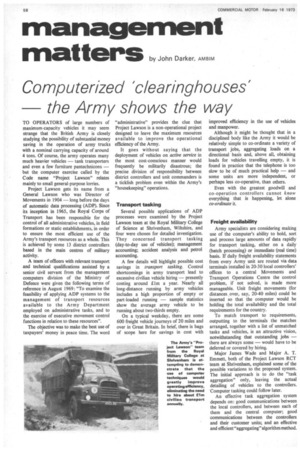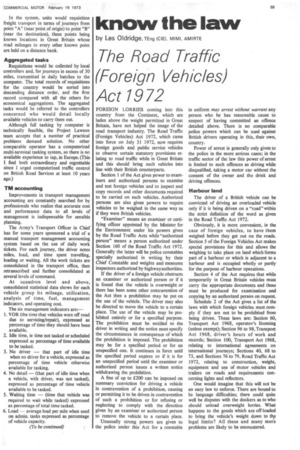management
Page 60

Page 61

If you've noticed an error in this article please click here to report it so we can fix it.
matters by John Darker, AMEN
Computerized 'clearinghouses' the Army shows the way
TO OPERATORS of large numbers of maximum-capacity vehicles it may seem strange that the British Army is closely studying the possibility of substantial money saving in the operation of army trucks with a nominal carrying capacity of around 4 tons. Of course, the army operates many much heavier vehicles — tank transporters and even a few furniture pantechnicons — but the computer exercise called by the Cale name "Project Lawson" relates mainly to small general-purpose lorries.
Project Lawson gets its name from a General Lawson who was Director of Movements in 1904 — long before the days of automatic data processing (ADP). Since its inception in 1965, the Royal Corps of Transport has been responsible for the control of all administrative vehicles, in field formations or static establishments, in order to ensure the most efficient use of the Army's transport resources as a whole. This is achieved by some 13 district controllers based in the main centres of military activity.
A team of officers with relevant transport and technical qualifications assisted by a senior civil servant from the management computers division of the Ministry of Defence were given the following terms of reference in August 1969: "To examine the feasibility of applying ADP systems to the management of transport resources available to the Army Department employed on administrative tasks, and to the exercise of executive movement control functions in relation to these resources".
The objective was to make the best use of taxpayers' money in peace time. The word "administrative" provides the clue that Project Lawson is a non-operational project designed to leave the maximum resources available to improve the operational efficiency of the Army.
It goes without saying that the deployment of vehicles on active service in the most cost-conscious manner would frequently be militarily disastrous; the precise division of responsibility between district controllers and unit commanders is a ticklish problem even within the Army's "housekeeping" operations.
Transport tasking Several possible applications of ADP processes were examined by the Project Lawson team at the Royal Military College of Science at Shrivenham, Wiltshire, and four were chosen for detailed investigation. They concerned transport tasking (day-to-day use of vehicles); management accounting; accident analysis and petrol accounting.
A few details will highlight possible cost savings in transport tasking. Control shortcomings in army transport lead to excessive civilian vehicle hiring — presently costing around Lim a year. Nearly all long-distance running by army vehicles includes a high proportion of empty or part-loaded running — sample statistics show the average army vehicle to be running about two-thirds empty.
On a typical weekday, there are some 600 freight vehicle journeys of 20 miles and over in Great Britain. In brief, there is bags of scope here for savings in cost with improved efficiency in the use of vehicles and manpower.
Although it might be thought that in a disciplined body like the Army it would be relatively simple to co-ordinate a variety of transport jobs, aggregating loads on a directional basis and, above all, obtaining loads for vehicles travelling empty, it is found in practice that the telephone is too slow to be of much practical help — and some units are more independent, or perhaps less co-operative, than others.
Even with the greatest goodwill and co-operation controllers cannot know everything that is happening, let alone co-ordinate it.
Freight availability Army specialists are considering making use of the computer's ability to hold, sort and process large amounts of data rapidly for transport tasking, either on a daily (batch processing) or immediate (real time) basis. If &illy freight availability statements from every Army unit are routed via data terminals installed in 20-30 local controllers' offices to a central Movements and Transport Operations Centre the control problem, if not solved, is made more manageable. Unit freight movements (for distances over, say, 20-40 miles) could be inserted so that the computer would be holding the total availability and the total requirements for the country.
To match transport to requirements, outputting to the terminals the matches arranged, together with a list of unmatched tasks and vehicles, is an attractive vision, notwithstanding that outstanding jobs — there are always some — would have to be deferred or covered by hiring.
Major James Wade and Major A. T. Emmett, both of the Project Lawson RCT team at Shrivenham, explained some of the possible variations to the proposed system. The initial approach is to do the "task aggregation" only, leaving the actual detailing of vehicles to the controllers. Computer tasking could follow later.
An effective task aggregation system depends on: good communications between the local controllers, and between each of them and the central computer; good communications between the controllers and their customer units; and an effective and efficient "aggregating" algorithm method. In the system, units would requisition freight transport in terms of journeys from point "A" (near point of origin) to point "B" (near the destination), these points being known locations in Great Britain whose road mileages to every other known point are held on a distance bank.
Aggregated tasks
Requisitions would be collected by local controllers and, for journeys in excess of 30 miles, transmitted in daily batches to the computer. The total records of requisitions for the country would be sorted into descending distance order, and the first record compared with all the others for economical aggregations. The aggregated tasks would be referred to the controllers concerned who would detail locally available vehicles to carry them out.
Although full tasking by computer is technically feasible, the Project Lawson team accepts that a number of practical problems demand solution. No other comparable operator has a computerized multi-terminal tasking system, so there is no available experience to tap, in Europe. (This I find both extraordinary and regrettable since I urged computerized traffic control on British Road Services at least 10 years ago.)
TM accounting
Improvements in transport management accounting are constantly searched for by professionals who realize that accurate cost and performance data to all levels of management is indispensable for sensible planning.
The Army's Transport Officer in Chief has for some years sponsored a trial of a manual transport management accounting system based on the use of daily work tickets. For each journey, the driver notes miles, load, and time spent travelling, loading or waiting. All the work tickets are consolidated in the transport office, then retranseribed and further consolidated at several levels of command.
At squadron level and above, consolidated statistical data shows for each vehicle group its mileage, utilization, analysis of time, fuel, management indicators, and operating cost.
The six management indicators are:—
I. VOR (the time that vehicles were off road due to servicing/repair), expressed as percentage of time they should have been available.
2. Idle time, ie time not tasked or scheduled expressed as percentage of time available to be tasked.
3. No driver — that part of idle time when no driver for a vehicle, expressed as percentage of time vehicle otherwise available for tasking.
4. No detail — (that part of idle time when a vehicle, with driver, was pot tasked), expressed as percentage of time vehicle available to be tasked.
5. Waiting time — (time that vehicle was required to wait while tasked) expressed as percentage of total time tasked.
6. Load — average load per mile when used on admin. tasks expressed as percentage of vehicle capacity.












































































































